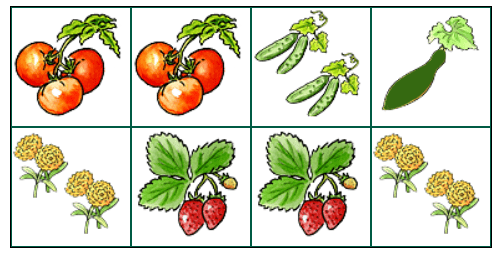As I was spring cleaning my craft supplies last week, one thing became very obvious: I have a tendency to overbuy for any new project. I get excited and jump in with both feet, buying everything I could possibly need…in bulk.
We love growing our own food. This weekend, I was planning to buy my seedlings, but I realized that I was doing the same thing. Rather than rushing to buy them when the garden isn’t even ready, I stuck with the soil mix and decided to research layouts, planting times, etc., before I bought the plants.
I bought peat moss, vermiculite, and compost at Lowes and mixed them together to fill my garden box. Then, I marked the squares with string.
Based on the concern that some commenters shared on my original tabletop garden post that my plants would be too crowded — and the suggestion that others made to use a trellis across the back for the vine-growing veggies — I decided to go ahead and eliminate the winter squash for this year and just plant two squares of marigolds.
Then I used this very cool garden planner from Gardener’s Supply Company, which also includes tips for growing each plant, and created this layout, which also shows how many plants you should plant per square:
 **I colored the zucchini green because they only had a yellow squash
**I colored the zucchini green because they only had a yellow squash
Table of Contents
Tomatoes
- Plant seeds 1/4″ deep indoors, six to eight weeks before the last frost
- Transplant into the garden one to two weeks after the last frost or when the soil reaches 65 degrees F.
- Spacing: one plant per sq. ft. Grow early-season crops nearby to allow more room later.
- Days to harvest: 55 to 100 days from transplanting, depending on variety. Not frost-hardy
- Hint: Remove lower leaves before planting and bury extra stems.
Cucumbers
- Plant seeds indoors 1/2″ deep three weeks before the last frost or seeds in the garden after the frost.
- Transplant into garden after frost and when soil is 65 to 70 degrees F.
- Spacing one per sq. ft. for bush type; and two per sq. ft. for vining type.
- Extend harvest with a second crop, planted two weeks later.
- Days to harvest: 50 to 60 days after transplanting. Not frost-hardy.
- Hint: Use row covers until flowering to keep off insects.
Zucchini
- Plant seeds 3/4″ deep indoors or outdoors three weeks after the last frost or when soil is 70 degrees F.
- Transplant three weeks after the last frost or when soil is 70 degrees F.
- When picked frequently, plants will produce continuously until frost.
- Spacing: one plant per sq. ft. for bush varieties; two plants per sq. ft. for vining types growing on trellis.
- Days to harvest: 30 to 40 days from transplant; 40 to 50 from seed. Not frost-hardy.
- Hint: Start under the garden fabric (row covers) to protect from insects.
- Here is a recipe for the overabundance of Zucchini.
Strawberries
**I’m a little confused by their recommendation of one per square because everything else I’ve read has recommended four per square.
- Plant in very early spring as soon as the ground can be worked.
- Space plants 12″ apart. Position carefully, keeping the crown of the plant even with the soil surface.
- Everbearing cultivars will bear a more abundant crop if all flowers are removed by the end of June.
- Provide 1″ of water per week. Keep soil mulched to retain moisture and protect fruit from rot.
Marigolds
- Sow seeds directly in the ground in early spring.
- Spacing: two plants per sq. ft.
- Replant any time you have a little space in the garden. Fast-growing.
- Days to bloom: 55 days from planting seeds
- Hint: Pick off spent flowers to keep the plant blooming.
This coming weekend, I’ll probably add the trellis. I may also go ahead and buy the marigolds and strawberries and plant those, but I think it’s still too early for the others since we had freezing temperatures last week. All in all, I like this slow-and-steady approach because I haven’t spent a ton of money, and I’m not feeling overwhelmed or rushed!
Here’s a link for some great tips for growing your own food.
Are you growing a vegetable garden this year so you will have fresh food to eat? What are you planting? What about getting a mushroom kit to grow?



